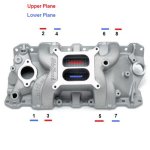IF??? You have a fuel shut off??? then you can run it out of gas(my opinion,not a good idea).
If you don't have one,then don't run it empty.
If you run it out of fuel, you don't burn all the gas.You leave a small bit in the crooks and crannies.
It will dry out faster because not much is there.
It will gum up quicker.
The tank should be full when left for any length of time.
Condensation forms in a partially filled tank a lot quicker than a full one.
The oil should be changed when you winterize.
That way you'll know if it has any problems(water,metal shavings etc.).
The sta-bil is a good idea.Even in the summer.
It should be added the last trip out so it can circulate in the system/
Just adding it when the winterizing is done won't get it circulated as well.
Depending on the motor and weather or not you have a closed system.
Draining and leaving it empty isn't as good as leaving it full of anti-freeze or a substitute.
The exposed metal of the crank case and the manifolds will rust faster if it only has air in the system.
My job would be: Add sta-bil,change oil,drive and motor.
Flush the system,remove drain plugs and clean out any blockages/sand etc.
Fog.
Drain and fill with a good marine approved anti-freeze.(auto anti-freeze is illegal to flush into the lakes/rivers/ocean)
Grease the fittings, drop the drive and grease the u-joint fittings and check the bellows,Make sure the water(#1) passages are clear.Reinstall drive,new gasket,remove prop,grease the shaft.
Depending on the boats extras? Sink? Head? They'd get drained and air blown through the lines.
It's been a few years since I've winterized anything,but I think I got most of it.
The batteries should be taken out and stored inside where they won't freeze.Then again my car battery froze every winter when I lived in.MI. and Md.
The 135$ for a dealer is ok.
Just not the job you should have done.
He probably won't drop the drive?? Or grease anything. I wouldn't be happy with that job at all.

#1 there is a small screw on the side of your drive that needs to be loosened and drained if the drive isin't removed.




